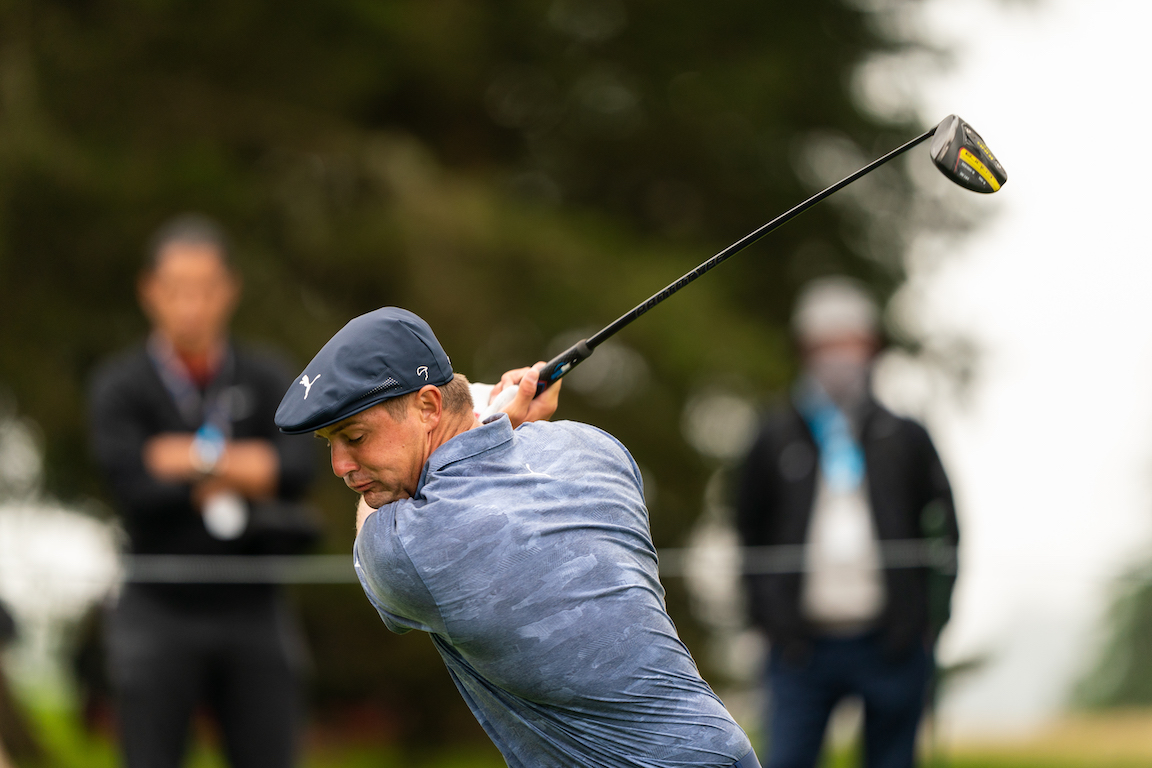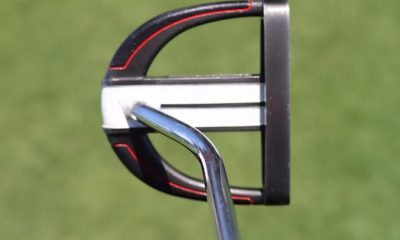Instruction
What is ground force in the golf swing?

There is no doubt about it, the guys and gals on tour have found something in the ground—and that something is power and speed. I’m sure by now you have heard of “ground reaction forces”—and I’m not talking about how you “shift your weight” during the golf swing.
Ground force in the golf swing: Pressure and force are not equal
With respect to ground force in the golf swing, it’s important to understand the difference between pressure and force. Pressure is your perception of how your weight is being balanced by the structure, in this case, the human body. Your body has a center of mass which is located roughly one inch behind the belt buckle for men and about one inch lower in women. When we shift (translate and/or torque) the center of mass, we create a pressure shift as the body has to “rebalance” the mass or body. This pressure shift can help us understand some aspects of the golf swing, but when it comes to producing power, force and torque are where it’s at.
Pressure can only be expressed in relation to the mass or weight of the body. Therefore, if you weigh 150 pounds, you can only create 150 pounds of pressure at one time. However, when we direct that mass at a larger object than our mass, all of a sudden that larger mass directs an opposite and equal reactionary force. So now, when a human being “pushes” their legs against the ground and “feels” 150 pounds of pressure, they now get 150 pounds of force directed back towards them from the ground, creating a total of 300 pounds of force that allows them to jump off the ground in this scenario.
If ground reaction forces don’t have anything to do with the “weight shift,” then what do they affect? Everything!
Most people use the same basic ingredients to make chocolate chip cookies. However, almost everyone has chocolate chip cookies that taste slightly different. Why is that? That is because people are variable and use the ingredients in different amounts and orders. When we create a golf swing, whether we are aware of it or not, we are using the same basic ingredients as everyone else: lateral force, vertical torque, and vertical force. We use these same three forces every time we move in space, and how much and when we use each force changes the outcome quite a bit.
Welcome to the world of 3D!
Understanding how to adjust the sequencing and magnitude of these forces is critical when it comes to truly owning and understand your golf swing. The good news is that most of our adjustments come before the swing and have to do with how we set up to the ball. For example, if an athlete is having a hard time controlling low point due to having too much lateral force in the golf swing (fats and thins), then we narrow up the stance width to reduce the amount of lateral force that can be produced in the swing. If an athlete is late with their vertical force, then we can square up the lead foot to promote the lead leg straightening sooner and causing the vertical force to happen sooner.
While we all will need to use the ground differently to play our best golf, two things need to happen to use the ground effectively. The forces have to exist in the correct kinetic sequence (lateral, vertical torque, vertical force), and the peaks of those forces need to be created within the correct windows (sequencing).
- Lateral force – Peak occurs between top-of-swing and lead arm at 45 degrees
- Vertical torque – Peak occurs between lead arm being 45 degrees and the lead arm being parallel to the ground.
- Vertical force – Peak occurs between lead arm being parallel to the ground the club shaft being parallel to the ground.
While it may seem obvious, it’s important to remember ground reaction forces are invisible and can only be measured using force plates. With that said, their tends to be apprehension about discussing how we use the ground as most people do not have access to 3D dual force plates. However, using the screening process designed by Mike Adams, Terry Rowles, and the BioSwing Dynamics team, we can determine what the primary forces used for power production are and can align the body in a way to where the athlete can access his/her full potential and deliver the club to the ball in the most effective and efficient way based off their predispositions and anatomy.
In addition to gaining speed, we can help athletes create a better motion for their anatomy. As golfers continue to swing faster, it is imperative that they do so in a manner that doesn’t break down their body and cause injury. If the body is moving how it is designed, and the forces acting on the joints of the body are in the correct sequence and magnitude, not only do we know they are getting the most out of their swing, but we know that it will hold up and not cause an unforeseen injury down the road.
I truly believe that force plates and ground reaction forces will be as common as launch monitors in the near future. Essentially, a launch monitor measures the effect and the force plates measure the cause, so I believe we need both for the full picture. The force plate technology is still very expensive, and there is an educational barrier for people seeking to start measuring ground reaction forces and understanding how to change forces, magnitudes, and sequences, but I’m expecting a paradigm shift soon.
- LIKE93
- LEGIT18
- WOW10
- LOL8
- IDHT3
- FLOP10
- OB5
- SHANK60
Instruction
Clement: Laid-off or perfect fade? Across-the-line or perfect draw?

Some call the image on the left laid off, but if you are hitting a fade, this could be a perfect backswing for it! Same for across the line for a draw! Stop racking your brain with perceived mistakes and simply match backswing to shot shape!
- LIKE0
- LEGIT0
- WOW0
- LOL0
- IDHT0
- FLOP0
- OB0
- SHANK1
Instruction
The Wedge Guy: The easiest-to-learn golf basic

My golf learning began with this simple fact – if you don’t have a fundamentally sound hold on the golf club, it is practically impossible for your body to execute a fundamentally sound golf swing. I’m still a big believer that the golf swing is much easier to execute if you begin with the proper hold on the club.
As you might imagine, I come into contact with hundreds of golfers of all skill levels. And it is very rare to see a good player with a bad hold on the golf club. There are some exceptions, for sure, but they are very few and very far between, and they typically have beat so many balls with their poor grip that they’ve found a way to work around it.
The reality of biophysics is that the body moves only in certain ways – and the particulars of the way you hold the golf club can totally prevent a sound swing motion that allows the club to release properly through the impact zone. The wonderful thing is that anyone can learn how to put a fundamentally sound hold on the golf club, and you can practice it anywhere your hands are not otherwise engaged, like watching TV or just sitting and relaxing.
Whether you prefer an overlap, interlock or full-finger (not baseball!) grip on the club, the same fundamentals apply. Here are the major grip faults I see most often, in the order of the frequency:
Mis-aligned hands
By this I mean that the palms of the two hands are not parallel to each other. Too many golfers have a weak left hand and strong right, or vice versa. The easiest way to learn how to hold the club with your palms aligned properly is to grip a plain wooden ruler or yardstick. It forces the hands to align properly and shows you how that feels. If you grip and re-grip a yardstick several times, then grip a club, you’ll see that the learning curve is almost immediate.
The position of the grip in the upper/left hand
I also observe many golfers who have the butt of the grip too far into the heel pad of the upper hand (the left hand for right-handed players). It’s amazing how much easier it is to release the club through the ball if even 1/4-1/2″ of the butt is beyond the left heel pad. Try this yourself to see what I mean. Swing the club freely with just your left hand and notice the difference in its release from when you hold it at the end of the grip, versus gripping down even a half inch.
To help you really understand how this works, go to the range and hit shots with your five-iron gripped down a full inch to make the club the same length as your seven-iron. You will probably see an amazing shot shape difference, and likely not see as much distance loss as you would expect.
Too much lower (right) hand on the club
It seems like almost all golfers of 8-10 handicap or higher have the club too far into the palm of the lower hand, because that feels “good” if you are trying to control the path of the clubhead to the ball. But the golf swing is not an effort to hit at the ball – it is a swing of the club. The proper hold on the club has the grip underneath the pad at the base of the fingers. This will likely feel “weak” to you — like you cannot control the club like that. EXACTLY. You should not be trying to control the club with your lower/master hand.
Gripping too tightly
Nearly all golfers hold the club too tightly, which tenses up the forearms and prevents a proper release of the club through impact. In order for the club to move back and through properly, you must feel that the club is controlled by the last three fingers of the upper hand, and the middle two fingers of the lower hand. If you engage your thumbs and forefingers in “holding” the club, the result will almost always be a grip that is too tight. Try this for yourself. Hold the club in your upper hand only, and squeeze firmly with just the last three fingers, with the forefinger and thumb off the club entirely. You have good control, but your forearms are not tense. Then begin to squeeze down with your thumb and forefinger and observe the tensing of the entire forearm. This is the way we are made, so the key to preventing tenseness in the arms is to hold the club very lightly with the “pinchers” — the thumbs and forefingers.
So, those are what I believe are the four fundamentals of a good grip. Anyone can learn them in their home or office very quickly. There is no easier way to improve your ball striking consistency and add distance than giving more attention to the way you hold the golf club.
More from the Wedge Guy
- The Wedge Guy: Golf mastery begins with your wedge game
- The Wedge Guy: Why golf is 20 times harder than brain surgery
- The Wedge Guy: Musings on the golf ball rollback
- LIKE86
- LEGIT13
- WOW6
- LOL1
- IDHT0
- FLOP4
- OB1
- SHANK8
Instruction
Clement: Stop ripping off your swing with this drill!

Not the dreaded headcover under the armpit drill! As if your body is defective and can’t function by itself! Have you seen how incredible the human machine is with all the incredible feats of agility all kinds of athletes are accomplishing? You think your body is so defective (the good Lord is laughing his head off at you) that it needs a headcover tucked under the armpit so you can swing like T-Rex?
- LIKE0
- LEGIT2
- WOW2
- LOL0
- IDHT0
- FLOP0
- OB0
- SHANK2
-

 19th Hole2 weeks ago
19th Hole2 weeks agoDave Portnoy places monstrous outright bet for the 2024 Masters
-

 19th Hole3 days ago
19th Hole3 days agoJustin Thomas on the equipment choice of Scottie Scheffler that he thinks is ‘weird’
-

 19th Hole2 weeks ago
19th Hole2 weeks agoTiger Woods arrives at 2024 Masters equipped with a putter that may surprise you
-

 19th Hole3 days ago
19th Hole3 days ago‘Absolutely crazy’ – Major champ lays into Patrick Cantlay over his decision on final hole of RBC Heritage
-

 19th Hole2 weeks ago
19th Hole2 weeks agoTwo star names reportedly blanked Jon Rahm all week at the Masters
-

 19th Hole1 week ago
19th Hole1 week agoReport: LIV Golf identifies latest star name they hope to sign to breakaway tour
-

 19th Hole1 week ago
19th Hole1 week agoNeal Shipley presser ends in awkward fashion after reporter claims Tiger handed him note on 8th fairway
-

 19th Hole1 week ago
19th Hole1 week agoBrandel Chamblee has ‘no doubt’ who started the McIlroy/LIV rumor and why
























geohogan
Mar 28, 2021 at 2:44 pm
Clubhead speed comes from momentum created by a pivot and COAM, (conservation of angular momentum)
As Frank stated above, attempting to create speed from the lower body will only result in injury to knees and the spine. Byron Nelson and the other great swingers, used the lower body(flexed knees) to support their pivot and maintain balance, not to create force.
Greg McNeill
Mar 8, 2021 at 1:28 pm
I’ve always found this explanation to be helpful: https://www.youtube.com/watch?v=qQVFhqAKcMg
geohogan
Mar 7, 2021 at 10:52 am
https://en.wikipedia.org/wiki/Ground_reaction_force
Our movements(golf swing) are dependent upon Newtons Laws, always have been.
Head Spinning
Mar 7, 2021 at 7:38 am
Michael, nothing Michael personal. But Michael can you Michael redo your Michael bio and not Michael talk about Michael yourself in Michael the third Michael person?
Robert Johansson
Mar 7, 2021 at 6:37 am
Only one guy understand the golf swing in the world
Soon you will to once my stuff is out there
Frank
Mar 7, 2021 at 11:47 pm
Ground force training AKA back and knee surgery at 40. You think Byron Nelson knees flexing well into his followthrough created much ground force? Probably not but it sure helped him get 68.33 scoring average with a 67.65 final round average, the latter which is still a record today. All this knee straightening that Rory and Justin Thomas do to get more ground force and distance is so bad for the body…
Johnny Rocket
Mar 7, 2021 at 4:19 am
Is this a joke?
Mianni Gagliocco
Mar 7, 2021 at 1:17 am
And here I thought ground force was how high my ball bounced off the concrete in the parking lot on a wayward chip.
Bud
Mar 6, 2021 at 10:06 pm
Huh?
The Dudeness Dude
Mar 6, 2021 at 8:48 pm
Average Person: Golf is so complicated !!!
Michael Dutro: Hold my beer, you ain’t seen NOTHING yet!!!
Ferry Bueller
Mar 6, 2021 at 8:50 pm
The one “like” is from Michael and the two “Legits” must be from friends and family members !!!
Livininparadise
Mar 9, 2021 at 2:25 pm
I hope thar everyone that I play with tries this. I will be buying a bunch of bitcoin by midway through the season. This is not a great explanation and even worse advice.